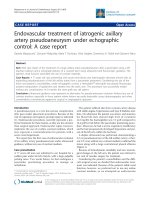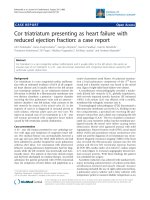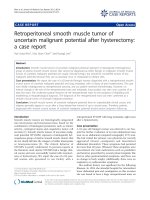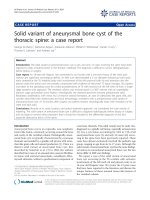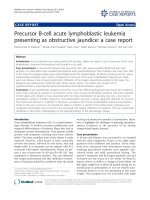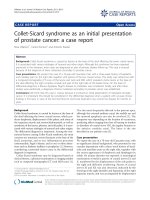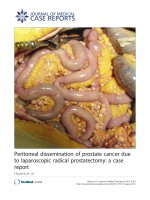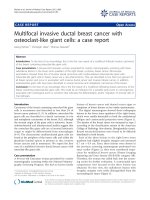Báo cáo y học: "Life-threatening hyperkalemia following zoledronic acid infusion for Paget’s Disease: a case report" pps
Bạn đang xem bản rút gọn của tài liệu. Xem và tải ngay bản đầy đủ của tài liệu tại đây (294.58 KB, 4 trang )
CASE REP O R T Open Access
Life-threatening hyperkalemia following
zoledronic acid infusion for Paget’s Disease:
a case report
Eleftheria Panteliou
*
, Neil Young and Morag Naysmith
Abstract
Introduction: Zoledronic acid is a highly effective treatment in Paget’s disease for persistent bone pain and
prevention of further progression of the disease. The commonest electrolyte abnormality is hypocalcemia. To the
best of our knowledge this is the first case of hyperkalemia secondary to zoledronic acid to be published in the
world literature. The commonest arrhythmia related to zoledronic acid is atrial fibrillation.
Case presentation: We describe the case of an 80-year-old Caucasian man, with a history of ischemic heart
disease, who had an in-hospital cardiac arrest related to hyperkalemia. Increasing potassium levels were noted
following his first zoledronic acid infusion for symptomatic control of bone pain secondary to Paget’s disease. Our
patient suffered a cardiac arrest 10 days following the zoledronic acid infusion. Our patient’ s biochemistry and
electrocardiogram output were monitored until his death 26 days after his cardiac arrest. Our patient developed
paroxysmal atrial fibrillation in the post-resuscitation period and there was persistent hyperkalemia that required
prolonged treatment with calcium resonium. All other possible causes of hyperkalemia were excluded.
Conclusion: In our patient’s case persistent hyperkalemia and life-threatening arrhythmias were associated with
use of zoledronic acid. These side effects have not been reported before and the causative mechanism is far from
clear as there are no obvious systemic effects of zoledronic acid. The combination of zoledronic acid with
predisposing factors such as structural heart disease might account for the clinical picture we witnessed. As a
result, electrolyte monitoring should be adopted early in zoledronic acid use. Further studies are req uired to
elucidate the underlying mechanism of hyperkalemia and identify the target group of patients where zoledronic
acid can be safely administered. Great caution is advised in patients with underlying heart conditions.
Introduction
Four million people are affected by Paget’s disease
worldwide. Zoledronic acid was licensed for the treat-
ment of Paget’s disease in the UK in 2005 and is highly
effective providing a pro longed remission after a single
intravenous infusion. In the HORIZON (’Health Out-
comes and Reduced Incidence with Zoledronic acid
ONce yearly’) study, involving 10,000 patients, flu-like
symptoms, atrial fibrillation and transient renal dysfunc-
tion were the commonest side effects. Low calcium,
phosphate , magnesium and potassium levels are com-
mon electrolyte disturbances described in the literature.
One death related to hyperkalemia and acute renal
failure in an older patient with osteoporosis and bone
metastases following his second zoledronate infusion has
been reported to the Medicines and Healthcare Products
Regulatory Agency (MHRA) [1]. Hyperkalemia is also
documented as a rare side effect on the producing com-
pany’ s database. To the best of our knowledge our
report is the first published case.
Zoled ronic is a very useful treatment for a large num-
ber of patients with a variety of conditions. Potentially
fatal side effects, which may r emain unnoticed as the
majority of patients receive their treatment in an out-
patient sett ing, should become more widely known and
efforts should be made to identify and monitor high-risk
patients.
* Correspondence:
Intensive Care Unit, Department of Critical Care and Anaesthetics, Western
General Hospital, Crewe Road South EH4 2XU, Edinburgh, UK
Panteliou et al. Journal of Medical Case Reports 2011, 5:367
/>JOURNAL OF MEDICAL
CASE REPORTS
© 2011 Panteliou et al; licensee BioMed Central Ltd. This is an Open Access article distributed under the terms of the Creative
Commons Attribution Li cense (http://creativeco mmons.org/licenses/b y/2.0), which permits unrest ricted use, distribution, and
reproduction in any m edium, provided the original work is properly cited.
Case presentation
An 80-year-old Caucasian man, who was admitted to
our facility for symptomatic c ontrol of bone pain sec-
ondary to Paget’ s disease, had an in-hospital cardiac
arrest related to hyperkalemia following his first zole-
dronic acid infusion. Despite having had coronary artery
bypass grafting for myoc ardial infarction in the past,
there were no ongoing cardiac symptoms. Progressively
increasing potassium levels were noted after a single 5
mg zo ledronic acid infus ion (Figure 1) . His renal func-
tion remained normal. On admission his potassium level
was 4.9 mmol/L (normal range: 3.6 to 5 mmol/L),
sodium level 1 36 mmol/L (normal r ange 135 to 145
mmol/L), urea level 11.3 m mol/L (normal r ange 1.7 to
8.3 mmol/L), creatinine level 85μmol/L (normal range
58 to 96μmol/L), estimated glomerular filtration rate
(eGFR) >60 mL/minute/1.73 m
2
, calcium level 2.27
mmol/L (normal range 2.1 to 2.6 mmol/L), phosphate
level 1.21 mmol/L (normal range 0.8 to 1.4 mmol/L),
25-hydr oxyvitamin D leve l 36 nmol/L (normal range 80
to 150 n mol/L) and alka line phosphatas e level 4973 IU/
L (normal range 42 to 128 IU/L). The night prior to his
cardiac arrest, his potassium level reached 6.3 mmol/L
and our patient received an infusion of insulin and dex-
trose, as well as calcium gluconate, that resulted in his
potassium level being reduced t o 5.9 mmol/L. His elec-
trocardiogram results showed bifascicular block and
atrial flutter with variable block and a heart rate of 75
beats/minute. His simultaneous calcium level was 2.15
mmol/L and magnesium level was 1.17 mmol/L (normal
range 0.7 to 1.0 mmol/L).
Our patient suffered a slow pulseless electrical activity
(PEA) cardiac arrest 10 days following the zoledronic
acid infusion, lost his cardiac output briefly, received 1
mg of adrenaline and 3 mg of atropine and was resusci-
tated according to the standard adult life support proto-
cols. His post-resuscitation electrocardiogram showed
irregular broad complex tachycardia. His post- cardiac
arrest blood results were as follows: potassium 7.3 mmol/
L, calcium 2.05 mmol/L (albumin 31 g/L), phosphate 1.3
mmol/L, magnesium 1 .17 mmol/L, hydrogen ions 57
nmol/L (normal range 35.5 to 44.5 nmol/L), base excess
-8.6 mmol/L (normal range -5 to +3 mmol/L) and lactate
7.8 mmol/L (normal range 0.4 to 2.2 mmol/L). As part of
his post-resuscitation care h e received a further insulin/
dextrose infusion and calcium gluconate.
Following cardiac arrest he maintained his blood pres-
sure and was transferred to the high dependency unit
(HDU) for monitoring and further management. Repeat
blood results showed potassium 4.3 mmol/L, calcium
1.98 mmol/L, hydrogen ions 38 nmol/L, base excess -1.8
mmol/L, b icarbonate 29 m Eq/L (normal range 18 to 23
mEq/L), lactate 3.3 mmol/L, creatinine 59μmol/L, eGFR
>60 mL/minute/1.73 m
2
. He was on slow release verapa-
mil for angina (he was b-blocker intolerant because of
asthma) that was temporarily discontinued. While in the
high-dependency unit he remained in paroxysmal atrial
fibrillation/flutter (heart rate 110 to 140 beats/minute).
The right bundle branch block noted two weeks prior to
the cardiac arrest persisted.
He also developed acute delirium related to hypoxia
secondary to pulmonary edema, for which he received
non-invasive continuous positive airway pressure
respiratory support. His echocardiogram showed mild
left ventricular dysfunction, dilated atria and mild pul-
monary and tricuspid regurgitation with mild pulmonary
hypertension. His troponin I level was mildly elevated,
which was not considered to be significant.
Figure 1 Potassium levels prior and after zoledronic acid infusion (day 0).
Panteliou et al. Journal of Medical Case Reports 2011, 5:367
/>Page 2 of 4
His medication history was reviewed and the only medi-
cationthathadrecentlybeenadministeredthatcouldbe
associated with the above biochemical results was zoledro-
nic acid. All other possible causes of hyperka lemia w ere
excluded (Table 1). Thyroid function and short synacthen
test results were normal. After his discharge from the
high-dependency unit his potassium was maintained
within the normal range on calcium resonium and his
hypocalcemia persisted. Verapamil was restarted in
increasing doses to control his ventricular rate. Our
patient died of pneumonia 26 days after his cardiac arrest.
He had paroxysmal atrial fibrillation until his death.
Discussion
Zolendronic acid is a bisphosphonate used in patients
with bo ne metastases from solid tumors, osteolytic
lesions in multiple myeloma, osteoporosis and Paget’ s
disease [2]. Zoledronic acid preferentially accumulates in
bone and is excreted u nchanged in the urine with a
half-life of 146 hours [3]. It causes disruption of the 3-
hydroxy-3-methyl-glutaryl coenzyme A (HMG-CoA)
reductase pathway that is essential for the production of
lipid-anchoring cell membrane proteins. Cholesterol
metabolites participate in the signaling pathway for
interleukin-6 (IL-6)-mediated inflammation [4]. Eleva-
tion of tumor necrosis factor and IL-6 occurs one to
two days following intravenous administration of
bisphosphonates [5] and can increase the incidence of
atrial fibrillation [6]. Atrial fib rillation is mo re common
with alendronate in patients taking statins (HMG-CoA
inhibitors) [7]. Black et al. reported a statistically signifi-
cant difference (P = 0.003) in the occurrence of serious
atrial fibrillation in the zoledronic acid group 9 to 11
days after the infusion compared to placebo, although
there was no diff erence in the incidence of all types of
atrial fibrillation between the two groups [8]. In the
HORIZON trial, involving post-menopausal women
with os teoporosis, atrial fibrillation occurred more than
30 days after the infusion. Our patient developed bifasci-
cular block and atrial flutter prior to his cardiac arrest
and paroxysmal atrial fibrillation and flutter in the post-
resuscitation period. Atrial remodeling and fibrosis have
been suggested as likely mechanisms for the develop-
ment of atrial fibrillation after bisphosphonate a dminis-
tration [9]. In our case no arrhythmia had been
clinically diagnosed prior to the infusion, despite the
history of ischemic heart disease.
Niemann and Cairns showed that successfully resusci-
tated animals do not exhibit electrolyte abnormalities
[10] and as a result the increased potassium level in our
case is thought to be the cause and not the result of the
cardiac arrest.
Conclusion
Zoledronic acid has unknown side effects, despite having
been tested prior to i ts wide clinical use. In our patient
persistent hyperkalemia and life-threatening arrhythmias
were associated wi th zoledronic acid infu sion. These side
effects have not been previously published and the causa-
tive mechanism is unclear, as zoledronic acid appears to
be bone specific with no obvious systemic effects. In our
case hyperkalemia was an early side effect tha t persisted
for approximately four weeks. Atrial fibrillation is a side
effect documented in the literature that was also present
in our case. Zoledro nic aci d in relation to ischemic heart
disease and structural heart abnormality might be more
commonly associated with the clinical picture we
observed. Heckbert et al. stated that there was no differ-
ence in the risk of developing atrial fibrillation with alen-
dronate in the subgroup with history of cardiovascular
disease [7]. When zoledronic aci d is used, close monitor-
ing of elec trolytes is recommended. The correct tim e for
initiating the monitoring and its duration are uncertain.
Further investigation as to the mechanisms underlying
the development of hyperkalemia, and arrhythmias in
association with zoledronic acid would be of benefit.
Caution would seem nece ssary in using zoledronic acid
in patients with known heart disease.
Consent
Written informed consent was obtained from the patient
(prior to his death) for publicatio n of this case report
and any accompanying images. A copy of the written
consent is available for review by the Editor-in-Chief of
this journal.
Authors’ contributions
EP collected the clinical data, reviewed the literature on the topic, and
drafted the manuscript. NY and MN reviewed and critically appraised the
manuscript. All authors have read and approved the final manuscript.
Table 1 Causes of hyperkalemia
Category Cause
Excessive potassium
intake
Potassium-containing dietary supplements,
intravenous potassium infusion
Ineffective potassium
renal excretion
Renal impairment
Hormonal Addison’s disease, congenital adrenal
hyperplasia, aldosterone deficiency, type IV
renal tubular acidosis
Intra-cellular potassium
release
Rhabdomyolysis, tumor lysis syndrome, blood
transfusion, hemolysis, beta blockers, digoxin
toxicity, low insulin levels
Medications Angiotensin-converting enzyme inhibitors,
amiloride, spironolactone, non-steroidal anti-
inflammatory drugs, ciclosporin, tacrolimus,
trimethoprim, pentamidine, heparin
Pseudohyperkalemia Hemolysis during venipuncture,
thrombocytosis, leukocytosis, polycythemia
Panteliou et al. Journal of Medical Case Reports 2011, 5:367
/>Page 3 of 4
Competing interests
The authors declare that they have no competing interests.
Received: 6 November 2010 Accepted: 12 August 2011
Published: 12 August 2011
References
1. UK Medicines and Healthcare Products Regulatory Agency: Intravenous
zoledronic acid: adverse effects on renal function.[.
uk/Safetyinformation/DrugSafetyUpdate/CON087704].
2. Van Beek E, Cohen L, Leroy I, Ebetino F, Löwik C, Papadopoulos S:
Differentiating the mechanisms of antiresorptive action of nitrogen
containing bisphosphonates. Bone 2003, 33:805-811.
3. Chen T, Berenson J, Vescio R, Swift R, Gilchick A, Goodin S, LoRusso S, Ma P,
Ravera C, Deckert F, Schran H, Seaman J, Skerjanec A: Pharmakokinetics
and pharmacodynamics of zoledronic acid in cancer patients with bone
metastases. J Clin Pharmacol 2002, 42:1228-1236.
4. Omoigui S: Cholesterol synthesis is the trigger and isoprenoid
dependent interleukin-6 mediated inflammation is the common
causative factor and therapeutic target for atherosclerotic vascular
disease and age-related disorders including osteoporosis and type 2
diabetes. Med Hypotheses 2005, 65:559-569.
5. Dicuonzo G, Vincenzi B, Santini D, Avvisati G, Rocci L, Battistoni F,
Gavasci M, Borzomati D, Coppola R, Tonini G: Fever after zoledronic acid
administration is due to increase in TNF- and IL-6. J Interferon Cytokine
Res 2003, 23:649-654.
6. Marcus GM, Whooley MA, Glidden DV, Pawlikowska L, Zaroff JG, Olgin JE:
Interleukin 6 and atrial fibrillation in patients with coronary artery
disease: data from the Heart and Soul Study. Am Heart J 2008,
155:303-309.
7. Heckbert SR, Li G, Cummings SR, Smith NL, Psaty BM: Use of alendronate
and risk of incident atrial fibrillation in women. Arch Intern Med 2008,
168:826-831.
8. Black DM, Delmas PD, Eastell R, Reid IR, Boonen S, Cauley JA, Cosman F,
Lakatos P, Chung Leung P, Man Z, Mautalen C, Mesenbrink P, Hu H,
Caminis J, Tong K, Rosario-Jansen T, Krasnow J, Hue TF, Sellmeyer D,
Eriksen EF, Cummings SR: Once-yearly zoledronic acid for treatment of
postmenopausal osteoporosis. New Engl J Med 2007, 356:1809-1822.
9. Boos CJ, Anderson RA, Lip GY: Is atrial fibrillation an inflammatory
disorder? Eur Heart J 2006, 27:136-149.
10. Niemann J, Cairns C: Hyperkalemia and ionized hypocalcemia during
cardiac arrest and resuscitation: possible culprits for postcountershock
arrhythmias? Ann Emerg Med 1999, 34:1-7.
doi:10.1186/1752-1947-5-367
Cite this article as: Panteliou et al.: Life-threatening hyperkalemia
following zoledronic acid infusion for Paget’s Disease: a case report.
Journal of Medical Case Reports 2011 5:367.
Submit your next manuscript to BioMed Central
and take full advantage of:
• Convenient online submission
• Thorough peer review
• No space constraints or color figure charges
• Immediate publication on acceptance
• Inclusion in PubMed, CAS, Scopus and Google Scholar
• Research which is freely available for redistribution
Submit your manuscript at
www.biomedcentral.com/submit
Panteliou et al. Journal of Medical Case Reports 2011, 5:367
/>Page 4 of 4
